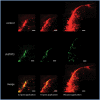STAT3 silencing inhibits glioma single cell infiltration and tumor growth
- PMID: 23486688
- PMCID: PMC3688009
- DOI: 10.1093/neuonc/not025
STAT3 silencing inhibits glioma single cell infiltration and tumor growth
Erratum in
- Neuro Oncol. 2013 Oct;15(10):1452
Abstract
Background: Diffuse infiltration remains the fulcrum of glioblastoma's incurability, leading inevitably to recurrence. Therefore, uncovering the pathological mechanism is imperative. Because signal transducer and activator of transcription 3 (STAT3) correlates with glioma malignancy and predicts poor clinical outcome, we determined its role in glioma single cell infiltration and tumor growth.
Methods: STAT3 was silenced in Tu-2449 glioma cells via lentiviral gene transfer. Target gene expression was measured by real-time reverse transcription PCR, Western blotting, and immunohistochemistry. Microvilli were visualized by staining with wheat germ agglutinin. Migration and invasion were measured by Scratch and Matrigel chamber assays. Diffuse infiltration was studied in 350-μm-thick organotypic tissue cultures over 14 days using cells tagged with enhanced green fluorescent protein and live confocal laser scanning microscopy. Survival of tumor-bearing syngeneic, immunocompetent B6C3F1 mice was analyzed by Kaplan-Meier plots.
Results: STAT3 silencing reduced cell migration and invasion in vitro and stopped single cell infiltration ex vivo, while STAT3-expressing cells disseminated through the neuropil at ∼100 µm/day. STAT3 silencing reduced transcription of several tumor progression genes. Mice with intracranial STAT3 knockdown tumors had a significant (P< .0007) survival advantage over controls, yielding 27% long-term survival. STAT3 knockdown reduced podoplanin expression 50-fold and inhibited concurrent microvilli formation. STAT3 knockdown tumors exhibited a weaker podoplanin immunoreactivity compared with controls. Podoplanin staining was diffuse, preferentially at tumor margins, and absent in normal brain.
Conclusions: Our results show compelling evidence that STAT3 is a key driver of diffuse infiltration and glioma growth and might therefore represent a promising target for an anti-invasive therapy.
Keywords: STAT3; brain slices; glioma mouse model; lentiviral gene transfer; single cell infiltration.
Figures







References
-
- Stupp R, Hegi ME, Gilbert MR, Chakravarti A. Chemoradiotherapy in malignant glioma: standard of care and future directions. J Clin Oncol. 2007;25(26):4127–4136. - PubMed
-
- Birner P, Toumangelova-Uzeir K, Natchev S, Guentchev M. STAT3 tyrosine phosphorylation influences survival in glioblastoma. J Neurooncol. 2010;100(3):339–343. - PubMed
Publication types
MeSH terms
Substances
LinkOut - more resources
Full Text Sources
Other Literature Sources
Medical
Miscellaneous

